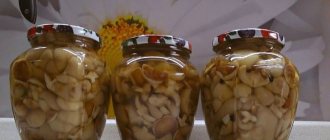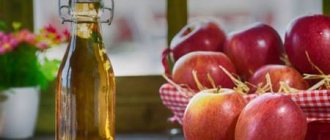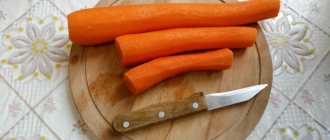Vinegar is a product used in cooking as a seasoning and preservative, containing a large amount of acetic acid, obtained from food alcohol-containing raw materials through microbiological synthesis using acetic acid bacteria. It is a colorless liquid with a specific aroma and a strongly sour taste.
The first vinegar, by fermenting wine, was obtained about 3 thousand years ago. Then winemakers discovered that if grape wine is not corked after preparation, then after a few weeks it sours and turns into a caustic and sour product that can be used as a seasoning and preservative. A little later, they learned to prepare vinegar from honey, vegetables, grains and fruits. But the principle of preparing vinegar has not changed over time: first, alcoholic fermentation is used, and then acetic acid.
Vinegar Information:
- Composition of vinegar;
- Types of vinegar;
- How to dilute vinegar;
- How to make vinegar at home; Recipes for making homemade apple cider vinegar;
- Recipe for making homemade wine vinegar;
- Benefits of apple cider vinegar;
Ingredients of vinegar:
Vinegar consists approximately:
- 97% from water;
- 3% from carbohydrates.
Vinegar can be natural or synthetic. Natural vinegar, depending on the product from which it is made, contains tartaric, malic, citric, succinic acid, acetic, oxalic, lactic, as well as aldehydes, alcohols and water. Synthetic vinegar contains acetic acid and water.
The vitamin and mineral composition of natural vinegar depends on the product from which it is made. Apple cider vinegar contains vitamins A, B1, B2, B6, C, E and minerals - calcium, magnesium, sodium, iron, potassium, copper, sulfur and phosphorus.
Wine vinegar contains vitamins A, B5, C and minerals - potassium, fluorine, sodium, zinc, copper, manganese, calcium, iron, magnesium and phosphorus. Synthetic table vinegar 9% contains no vitamins and minerals.
The calorie content of 100 grams of vinegar depends on its type:
- synthetic table vinegar 9% – 11.3 kcal;
- apple cider vinegar – 21 kcal;
- wine vinegar – 9 kcal;
- rice vinegar – 41 kcal;
- malt vinegar – 54 kcal.
Adjika with eggplant and honey
Another fairly popular recipe that does not claim to be a “traditional Caucasian” recipe is adjika with eggplant and honey. The pleasant spicy-sweet taste of the seasoning comes from the combination of vegetables and fruits with honey.
Ingredients (weighed in peeled form):
- 1 kg of tomatoes;
- 700 g eggplants;
- 500 g non-sour apples;
- 500 g bell pepper;
- 300 g onions;
- 1 hot pepper (take ½ and remove the seeds if you want to soften the heat);
- 6-7 cloves of garlic;
- 150 g honey;
- 1-1½ tbsp. spoons of salt;
- 150 ml refined vegetable oil;
- 70 ml of 9% table vinegar (or 50 ml of 6% apple cider vinegar).
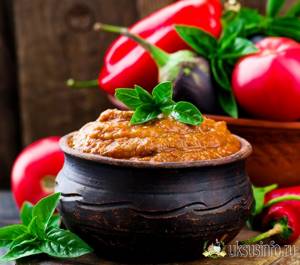
Preparation:
- Wash, peel and chop the vegetables in a meat grinder or blender (except for garlic and hot pepper).
- Add salt and oil to the vegetable puree, stir and place on low heat.
- Also chop the garlic and hot pepper using a meat grinder or blender.
- Cook the vegetable mass for 40-50 minutes. Gradually add hot peppers and garlic, constantly testing so as not to overdo it.
- Boil for another 5-10 minutes, add vinegar, honey, stir, bring to a boil and immediately remove from heat.
- Pour hot adjika into sterilized jars, turn over, let cool. The seasoning can be stored in a cool place all winter.
Types of vinegar:
Vinegar is classified according to the principle of preparation, the percentage of acetic acid content, and the starting substance from which it is prepared.
According to the principle of preparation, vinegar is:
- natural, obtained from natural products;
- synthetic, obtained by diluting acetic acid produced by chemical means.
Vinegar is classified according to its acetic acid content:
- 3% vinegar;
- 5% vinegar;
- 6% vinegar;
- 9% vinegar;
- any other % acetic acid content.
Vinegar, according to the product on which it is made, can be:
- Alcohol . This vinegar is produced by fermenting alcohol. It does not have a pleasant smell and is used mainly for marinating meat.
- Apple . It is obtained from apple cider. Most popular in Russia, USA and France. It has a pleasant aroma and slightly sour taste. It is used mainly for preparing fish dishes, pickling vegetables and acidifying sauces.
- Wine . This type of vinegar is obtained by fermenting wine or juice. It is widely distributed in wine-producing countries such as France. It can be white or red, depending on the type of wine it was prepared from. Has a pleasant smell. Mainly used for preparing marinades, sauces, and salad dressings.
- Rice . It is produced from glutinous rice varieties and comes in black, red and white. Most common in Asian countries. It is used mainly for making sushi, rice noodles, seafood, gravies and sauces. It makes a good marinade.
- Malt . This type of vinegar is made from beer wort. Most popular in the UK. It has a delicate taste and aroma. Mainly used for pickling fish and vegetables, as well as for canning. The British use it as a spice in their popular dish - fish and chips.
- Coconut . Made from coconut milk. Popular in the Philippines and India. It has a sweet taste and a pungent odor. Suitable for marinating pork and dressing for seafood and chicken salads.
- Reed . This type of vinegar is made by fermenting cane sugar syrup. Popular in southern countries where reed grows. It has a rich taste and unusual aroma. Excellent as a seasoning for fried poultry, fish and pork.
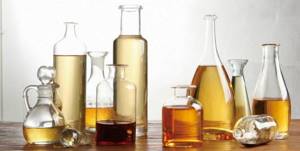
Grandma’s recipe for spicy adjika “Ogonyok”
Please note that this recipe does not use chili as the hot pepper. Depending on the spiciness of the red pepper, you can adjust its quantity. For 2 liters of prepared adjika you will need (the recipe gives the weight of unpeeled vegetables):
- 1 kg red sweet pepper;
- 200 g red hot pepper;
- 150 g garlic;
- 1 kg of tomatoes;
- 2 tbsp. spoons of salt;
- 3 tbsp. spoons of sugar;
- 70 ml 6% apple cider vinegar (or 50 ml 9% table vinegar)
- Cilantro, parsley to taste.

Preparation:
- Separate the garlic heads into cloves and soak them in warm water to make them easier to peel.
- Wash all vegetables well. Remove the stem from the tomatoes and cut them into halves.
- Cut out the stem of sweet and hot peppers and remove the seeds. Cut into four pieces to make chopping easier.
This is interesting! “The same taste of Abkhazian adjika” is given by crushed hot pepper seeds. You can grind them separately in a mortar and add them to the pan during cooking.
- Drain the garlic, remove the skin, and rinse under cold water.
- Using a meat grinder or blender, chop all the vegetables, squeeze the garlic through a press into a separate container.
- In a large saucepan, combine all the vegetables (except the garlic) and bring to a boil, stirring constantly.
- As soon as the mixture boils, add sugar and salt (gradually, tasting so as not to oversalt).
Helpful information! Hot adjika may seem spicier than cooled one. As it cools, the taste will become softer.
- Stirring occasionally, cook over low heat for 20 minutes, add garlic and herbs, continue cooking for another 10-15 minutes.
- As soon as a liquid transparent layer of juice begins to form on the surface, add vinegar.
- Stir everything again, bring to a boil and immediately remove from heat.
- Pour the prepared snack into sterilized jars, stirring the mixture well with a ladle so that the thick part does not have time to settle to the bottom of the pan.
- Roll up the jars, turn them over, and leave to cool at room temperature.
Additional Information! A couple of spoons of adjika can be used as a dressing for borscht!
How to dilute vinegar:
It often happens that there is vinegar essence or vinegar with a higher concentration of acetic acid than required in the recipe. In this case, it is not necessary to go to the store for vinegar with the required concentration of acetic acid, because it can be diluted with water. This is easy to do - you need to calculate in what proportions to mix vinegar and water, and then mix.
You can calculate the number of parts of water that need to be added to the original concentrated vinegar to obtain vinegar of a lower concentration using the following formula:
(Initial vinegar concentration / Required vinegar concentration) – 1.
For example, you have a tablespoon of 70% vinegar essence, and you want to get 9% vinegar from it. Let's use the formula: (70% / 9%) – 1 = 7.8 – 1 = 6.8. For simplicity, we round the resulting value to 7. From the formula it follows that to obtain 9% vinegar from 70% vinegar essence, you need to mix a tablespoon of 70% vinegar essence with 7 tablespoons of water.
Using this principle, you can calculate the number of parts of water that need to be added to concentrated vinegar to obtain vinegar with any lower acetic acid content. You just need to remember that the mixed parts must be equal - if you took a teaspoon of the original vinegar, then add parts of water to it by teaspoons, if you took a tablespoon of the original vinegar, then you need to dilute it with tablespoons of water, if you took 100 milliliters of the original vinegar , then you need to dilute it with as many parts of water as 100 milliliters each, which were obtained according to the formula, that is, 100 milliliters multiplied by the result of the formula.
Below are tables with proportions for diluting vinegar:
Dilution of vinegar essence:
| Desired vinegar solution | Original vinegar essence | ||
| 90% | 80% | 70% | |
| 3% | 29 | 25,7 | 22,4 |
| 4% | 21,5 | 19 | 16,5 |
| 5% | 17 | 15 | 13 |
| 6% | 14 | 12,4 | 10,7 |
| 7% | 11,9 | 10,5 | 9 |
| 8% | 10,3 | 9 | 7,8 |
| 9% | 9 | 7,9 | 6,8 |
| 10% | 8 | 7 | 6 |
The calculation field of this table indicates the number of parts of water that need to be added to 1 part of the original vinegar. The parts must be equal. For example, to obtain 3% vinegar from 70%, you need to add 22.4 equal parts of water to 1 part of 70% essence. For example, if the part is a teaspoon, then mix 1 teaspoon of 70% essence with 22.4 teaspoons of water. For simplicity, values can be rounded up.
Diluting vinegar:
| Desired vinegar solution | Original vinegar | ||
| 9% | 8% | 7% | |
| 3% | 2 | 1,7 | 1,4 |
| 4% | 1,3 | 1 | 0,8 |
| 5% | 0,8 | 0,6 | 0,5 |
| 6% | 0,5 | 0,4 | 0,2 |
| 7% | 0,3 | 0,2 | |
| 8% | 0,2 | ||
The calculation field of this table indicates the number of parts of water that need to be added to 1 part of the original vinegar. The parts must be equal. For example, to obtain 3% vinegar from 7%, you need to add 1.4 equal parts of water to 1 part of 7% vinegar. For example, if the part is a teaspoon, then mix 1 teaspoon of 7% vinegar with 1.4 teaspoons of water. For simplicity, values can be rounded up.
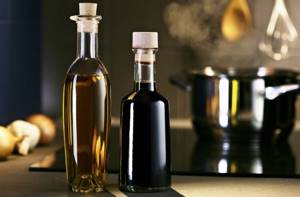
Secrets of making truly delicious adjika
A few useful tips will help you prepare adjika “right” the first time:
- To make the seasoning thicker, place a fine sieve directly on the adjika. Periodically remove the released juice.
- Choose ripe, “meaty” varieties of tomatoes for preparation - both the taste and consistency of the seasoning will depend on this.
- When cooking, pay attention to the pepper seeds - they are harder in ripe fruits. It is better to remove dry hard seeds so that the adjika does not turn out too spicy.
- You can remove some of the heat by soaking the pepper for 10-15 minutes in cold water (after removing the seeds).
- If the tomatoes turn out to be watery, start preparing the adjika by evaporating the excess liquid. Place the prepared tomatoes in a saucepan and simmer until the desired thickness, and then add the rest of the ingredients.

- Be sure to check how hot your pepper is before cooking. By slightly changing the amount in the recipe, you can adjust the spiciness of the seasoning.
- When cooked for a long time, garlic loses its taste and aroma; add it at the very end. The same goes for vinegar - when it is added to adjika in the middle of cooking, most of it evaporates.
- A beautiful homogeneous mass is obtained if 1-2 minutes before the end of cooking the seasoning, mix it with an immersion blender, bring it to a boil again and pour into jars.
- It is best to use natural, organic apple cider vinegar, which you can make yourself or buy at the store. Be sure to pay attention to the label - the name should say “natural” or “organic”.
How to make vinegar at home:
If you want to use 100% natural vinegar in your dishes, you can make it yourself. Most often in Russia, apple or wine vinegar is prepared at home.
Recipes for making homemade apple cider vinegar:
1. Apple cider vinegar from overripe apples:
To create this apple cider vinegar recipe you will need the following ingredients:
- overripe apples – 1 kilogram;
- granulated sugar – 50 grams for sweet apples or 100 grams for sour apples;
- water;
In addition to the ingredients, you will need a large enamel pan and jars.
If you have everything, then you can proceed to creating apple cider vinegar, following the step-by-step recipe:
- Wash the apples well.
- Cut the apples and crush the pieces.
- Boil water and cool to 70 degrees Celsius.
- Place the crushed apples in an enamel pan and add hot water so that the water covers the apples by a couple of centimeters.
- If the apples are sweet, add 50 grams of sugar to the pan, and if they are sour, add 100 grams. Mix.
- Place the pan in a dark and warm place and cover with a cloth. Leave for 2 weeks. Stir occasionally with a wooden spoon.
- Strain the contents of the pan into jars, leaving room to the brim for the vinegar to ferment, as it will increase in volume during fermentation.
- Leave for 2 weeks in a warm and dark place for further fermentation. If the liquid has brightened and acquired a pleasant sour taste, the fermentation process is complete.
- Strain the vinegar and pour into bottles for storage and use. Close the bottles tightly and store in a dark place.
Vinegar from overripe apples is ready!
2. Apple cider vinegar from regular apples:
To create apple cider vinegar for this recipe, you will need the following ingredients:
- apples – 1.5 kilograms;
- real bee honey – 150 grams;
- rye bread – 50 grams;
- water – 2 liters;
In addition to the ingredients, you will need a large enamel pan, jars and a grater.
If you have everything, then you can proceed to creating apple cider vinegar, following the step-by-step recipe:
- Boil 2 liters of water and cool to room temperature.
- Wash the apples well.
- Grate the apples on a coarse grater. Do not throw away the cores.
- Place the grated apples along with the cores in an enamel pan and add 2 liters of boiled water at room temperature, but do not fill to the brim, leaving room for fermentation.
- Place 50 grams of rye bread and 150 grams of real bee honey in a jar.
- Place the pan in a warm and dark place, cover with a cloth and leave for 12 days. Stir occasionally with a wooden spoon.
- Then strain the contents of the pan into jars and cover them with a cloth.
- Leave in a dark and warm place for a month. If the liquid has brightened and acquired a pleasant sour taste, the fermentation process is complete.
- Strain the vinegar and pour into bottles for storage and use. Cover well and store in a dark place.
Vinegar from regular apples is ready!
Recipe for making homemade wine vinegar:
To make grape vinegar at home you will need:
- grapes - half a three-liter jar;
- granulated sugar – 140 grams;
- water.
In addition to the ingredients, you will need a three-liter jar.
If you have all the ingredients, then you can proceed to creating wine vinegar, following the step-by-step recipe:
- Boil a little more than half a three-liter jar of water. And then cool to room temperature.
- Wash the grapes well, select diseased berries and discard.
- Place grapes up to half of a three-liter jar.
- Mash the grapes well in the jar with your hand.
- Fill the jar halfway with boiled water at room temperature.
- Add 70 grams of sugar.
- Mix well with a wooden spoon.
- Cover the jar with gauze and place in a dark and warm place for 12 days. Stir once a day with a wooden spoon.
- Strain the grape juice, squeeze out the pulp and discard it.
- Strain the juice into a three-liter jar.
- Add 70 grams of granulated sugar and mix well with a wooden spoon.
- Cover the jar with gauze and place in a dark and warm place for 2 months.
- As soon as the mixture stops fermenting and turns a little lighter, strain it into glass bottles.
- Seal the bottles with stoppers and store in a cool, dark place.
Wine vinegar is ready!
Using Vinegar
What is white vinegar used for - examples of use:
- In cooking. The product is widely used in cooking - as a dressing for vegetable salad (in combination with mayonnaise, sour cream or yogurt), as a preservative in vegetable preparations for the winter. They pour it over manti, and also extinguish soda to loosen baked goods. White vinegar is added to marinades to soften the fibers of meat, poultry and fish. It is a common component of mayonnaise and sauces.
- At home. White vinegar is used in households to disinfect surfaces, whiten things, and clean surfaces from organic contaminants. A transparent synthetic option is optimal for this - it will not stain the fabric, floor, or walls. To remove grease stains, the solution is diluted by half with water.
- For washing. You can disinfect your washing machine by pouring 50 ml of a white fermentation product into the rinse aid compartment. You can rid things of odors by soaking them in water with the addition of a fermentation product. Another option is to pour it into the fabric softener compartment when washing by machine.
- For auto. The use of 1.5% acetic acid helps to clean windows and surfaces from dirt in the interior and eliminate odors.
- In folk medicine. The product is used to lubricate insect bites to relieve itching, and rub the temples during a headache attack. Based on it, warm compresses are made (from 0.25 liters of liquid, 1 teaspoon of salt, 4 drops of iodine) if a muscle strain occurs. A solution for gargling for sore throat is obtained from apple white vinegar - 2 tbsp. l. per glass of water.
- In home cosmetology. Masks with the addition of apple cider vinegar are used to lighten and degrease the skin and eliminate freckles. To do this, connect 2 tbsp. l. sour and 1 tsp. fermentation product. Exposure time – 10 minutes. For shine, rinse hair with a solution (2 teaspoons of white vinegar per 200 ml of water) after each wash.
- For the garden and vegetable garden. Sprinkle on weeds and add to water for cut flowers.
- For weight loss. It is believed that the vinegar solution speeds up metabolism, increases fat burning, and reduces appetite if you drink 1 tbsp in the morning on an empty stomach. water with the addition of 1 tsp. apple cider vinegar. There is no reliable data on this matter, but it can damage tooth enamel and provoke the development of gastritis.
You can make an aromatic seasoning with spices from white vinegar - recipe:
- pour wine, apple or synthetic product into a glass container;
- add pieces of garlic and horseradish, sprigs of parsley, basil, dill;
- add honey or sugar - ½ tsp. for ½ liter of liquid;
- leave for a month in a dark place, shaking occasionally;
- strain;
- season meat, salads.
The components can be any and in arbitrary quantities - citrus zest, onion, sea buckthorn, lavender, nasturtium, rose hips, violet, chili pepper, etc.
Watch the educational story:
How to replace vinegar:
There are situations when you need to prepare a dish whose recipe includes vinegar, but you don’t have vinegar at home. Then the question arises, what can replace vinegar in the recipe? Everything is very simple. Vinegar can be replaced with citric acid or lemon juice.
Proportions for replacing vinegar with citric acid:
| What kind of vinegar analogue should you get: | Dilute 1 teaspoon of citric acid powder into: |
| 3% vinegar | 46 tablespoons water |
| 4% vinegar | 34 tablespoons water |
| 5% vinegar | 26 tablespoons water |
| 6% vinegar | 22 tablespoons water |
| 9% vinegar | 24 tablespoons water |
To obtain the equivalent of 70% vinegar essence, you need to dilute 1 tablespoon of citric acid in 2 tablespoons of water.
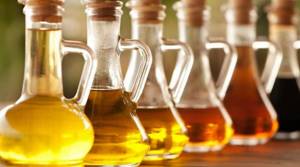
Beet adjika
Many will argue that such a snack cannot be called adjika. However, the seasoning recipe in different countries differs significantly from the traditional one: various vegetables and fruits, nuts and new spices are added to pepper ground with salt and spices. Fans of savory snacks will appreciate the original taste of this recipe.
Ingredients:
- 2 beets;
- 1 bell pepper;
- 1 hot pepper;
- 2-3 cloves of garlic (for those who like it spicier, you can add a couple more cloves);
- 100 g walnuts (optional);
- ½ teaspoon ground coriander;
- ½ teaspoon of cumin;
- 50 ml balsamic vinegar;
- 2½ tbsp. spoons of sugar;
- 1 tbsp. spoon of salt.

Preparation:
- Wash and dry the vegetables thoroughly. Peel, remove the stem and seeds from the peppers. If you want adjika to be truly spicy, leave the seeds from the hot pepper.
- Using a meat grinder or blender, chop the prepared vegetables (except garlic). Beets can also be grated on a coarse grater.
- Place the vegetable puree into a saucepan. Add salt, sugar, spices, bring to a boil and cook for 40-50 minutes over low heat.
- Add garlic squeezed through a press and vinegar. Bring to a boil and immediately remove from heat.
- Pour the finished hot adjika into pre-sterilized jars, roll up, and let cool at room temperature.
Note to the housewife: How to pickle ginger for sushi with vinegar at home
Table vinegar production technology:
In general, the technological scheme for preparing table vinegar in production includes 7 stages:
- First, the process of preparing the wort is carried out by mixing water, alcohol, various salts and sugar, which promotes the development of bacteria that will oxidize the main product and release acetic acid.
- Next, a filler in the form of birch or beech shavings is introduced into the oxidizer generators, which is irrigated with wort and a product for oxidation, for example, alcohol. Fermentation occurs. The alcohol is oxidized into acetic acid within 5 days.
- Next, the resulting vinegar is drained and clarified using gelatin and activated carbon.
- The liquid is filtered to remove sediment.
- The vinegar is then diluted with water to obtain a solution with the required acetic acid content.
- The vinegar is then pasteurized to increase its shelf life.
- Poured into containers and packaged.
Vinegar is produced according to “GOST R 56968-2016 Table vinegar. Technical conditions".
The shelf life of vinegar depends on its type and the percentage of acetic acid, it is indicated on the label.
How to select and store vinegar
Tips for choosing white vinegar:
- a synthetic product is always transparent, a natural one usually has sediment;
- the container is intact, there is no smell from under the lid;
- Natural apple product is made from apples, not malic acid.
Storage conditions and shelf life of white vinegar:
- apple – 24 months at +5–15 °C;
- from berries - up to 8 years in a cool room;
- synthetic – up to 15 years or unlimited at room temperature.
Any vinegar is stored in a glass container with a tightly closed lid. The place should be inaccessible to sunlight, children and animals. In the refrigerator, the taste of the product deteriorates.
Expired vinegar can be used for non-food purposes, for example, to clean the toilet with it, or to rinse things in the solution.
See the experts' opinion:
Benefits of vinegar:
Only natural vinegar containing vitamins and minerals can be beneficial to health, and synthetic vinegar does not provide any benefit to the human body, since it does not contain minerals and vitamins.
It is worth immediately noting that natural vinegar can benefit human health only if it is added to dishes as a seasoning or preservative in moderation, in the proportions specified in proven recipes. You can’t just drink vinegar, as you can get a chemical burn to the gastrointestinal tract and cause serious harm to the body. That is why vinegar should be stored out of the reach of children.
Benefits of apple cider vinegar:
Apple cider vinegar is made from apple juice and is rich in the minerals and vitamins found in apples. A small amount of apple cider vinegar that enters the body as part of the main dish helps strengthen the immune system due to the presence of a large amount of vitamins and minerals. Apple cider vinegar stimulates metabolic processes and speeds up digestion. It is useful because it improves the removal of toxins and waste from the body. Reduces cholesterol levels and improves the condition of blood vessels. Has antiseptic and diuretic properties. Helps strengthen hair and nails.
Benefits of wine vinegar:
Wine vinegar is made from grape juice, which makes it rich in minerals and vitamins found in grapes. When ingested as part of a main dish, wine vinegar slows down the aging process, lowers cholesterol, cleanses blood vessels and strengthens the cardiovascular system. Improves the functioning of the lungs, gastrointestinal tract and urinary system. Wine vinegar normalizes the functioning of the nervous system, improves hair and nails. It is an antioxidant and antiseptic.
You can use vinegar for weight loss. Apple cider vinegar diet: minus 5 kg in 5 days
“Vinegar diets” are considered effective: using apple cider vinegar, in particular, you can lose up to 5 kg in 5 days without much effort or restrictions. At first glance, everything is simple: dilute two teaspoons of apple cider vinegar in a glass of water and drink 3-4 times a day. At the same time, metabolism accelerates, appetite decreases, and intestinal function improves. It would seem, what else is needed for a happy life? However, not all so simple.
Apple cider vinegar in certain doses can really be useful: to a certain extent, it regulates acid-base metabolism and improves the secretory function of the stomach. Stimulation of metabolic processes in the body, as a rule, increases performance, and a person has a feeling of lightness. And if you manage to lose three to five kilograms in a week, then your mood improves.
However, not everything is so simple and safe in this “power system”. Apple cider vinegar contains 7% acid - in fact, it triggers processes that promote weight loss. But in addition to its benefits, acid can cause considerable harm to the body: disrupt the acid-base balance, damage the gastric mucosa, and damage tooth enamel.
What are the benefits of apple cider vinegar?
In addition to the fact that this sour product starts metabolism and improves digestive processes, it also reduces appetite: you want less unhealthy cakes. An acidic environment reduces the number of pathogenic bacteria and fungi in the gastrointestinal tract and normalizes the microflora.
Natural apple cider vinegar contains a lot of useful microelements: magnesium, calcium, potassium, iron, sodium. It also contains organic acids - glycolic, malic, as well as citric and acetic.
Apple cider vinegar is also an excellent anti-inflammatory agent. By the way, many of the “benefits” of apple cider vinegar have not yet been fully studied: it is known that it just works - that’s all!
Read how to make your own apple cider vinegar here.
How to lose weight with apple cider vinegar?
Before you go on such a diet, make sure that you are absolutely healthy. The main contraindications to it are from the gastrointestinal tract. Therefore, you can lose weight with vinegar only if you do not have gastritis, stomach or duodenal ulcers, or inflammation of the intestinal walls. The diet is also not suitable if you suffer from high acidity or suffer from reflux (heartburn). Have you ever encountered similar problems? Unfortunately, the vinegar diet is not suitable for you.
Vinegar must be diluted: 1 teaspoon per 1 glass of water. And drink this solution at the rate of 1 glass of “vinegar water” per 30 kg of weight - this is how the weight loss mechanism starts.
You can lose weight in three days: before each meal you need to drink vinegar water. At the same time, this will help fill your stomach, and your appetite will no longer be so brutal. On the second day you need to add a couple more doses: in the morning and evening before bed, 1 liter in total. Many people advise drinking vinegar in the morning on an empty stomach, but you shouldn’t do this - even diluted vinegar can harm the walls of the digestive tract. The third day is a fasting day on apples: you can drink water with apple cider vinegar whenever you want, plus eat 3-4 apples a day. The most difficult thing is to survive this particular day, it is the most “hungry”.
We repeat: even if you are confident in your health, you must follow the following rules:
- Drink only diluted vinegar.
- Drink only natural apple cider vinegar (preferably homemade).
- Drink diluted vinegar only after meals, and never do it on an empty stomach.
- After each use of vinegar, rinse your mouth with water - this will help you avoid dental problems.
- At the first alarming symptoms, stop taking vinegar and consult a gastroenterologist.
Alarming symptoms may be pain or simply discomfort in the stomach, aching pain on the right side under the ribs, bloating and pain when pressing on the stomach, nausea, and lack of appetite during the day.
Well, the most important thing. No magic remedy is magical in itself. All nutritionists who recommend the vinegar diet to their patients also advise them to eat less fatty meat and fish, butter, white bread, pastries, pasta, white polished rice, alcohol and sweets, and drink enough mineral water - up to 2 liters per day. And of course, don’t lie on the couch all these days: walk more, run in the park, sign up for a swimming pool or dancing. The effect will only be more noticeable!
Harm of vinegar:
Vinegar can cause the most serious harm to the body if it is drunk as a liquid. After which the person receives a chemical burn to the mucous membranes, food poisoning and kidney failure occur. That is why vinegar should be consumed only in small quantities as part of main dishes prepared according to proven recipes. The bottle of vinegar should be kept out of the reach of children to avoid poisoning the child.
But even in dishes, vinegar can be harmful and is contraindicated for people with diseases of the stomach and intestinal tract, such as gastritis, ulcers, colitis, enteritis, and hyperacidity. Vinegar can be harmful to these categories of people because it can aggravate these diseases. Also, people with obesity, nervous disorders, hypertension, nephritis, hepatitis, cholecystitis and cystitis should not use vinegar.
Healthy people without the mentioned diseases should consume vinegar in moderation as part of dishes prepared according to proven recipes. Only in this case, vinegar will not harm the body, and natural vinegar will have a beneficial effect on the body.
Source: www.konditer-club.ru
Adjika in Caucasian style
One of the recipes for thick Caucasian adjika is prepared from a mixture of bell and hot peppers, without adding tomatoes. If desired, you can add chopped walnuts and shamballa (fenugreek).
Ingredients:
- 500 g of juicy bell pepper;
- 250 g hot pepper;
- 125 g garlic;
- ½ teaspoon ground coriander;
- ½ teaspoon hops-suneli;
- ½ - 1 tbsp. a spoonful of salt (add gradually, to taste);
- ½ tbsp. spoons of table vinegar.
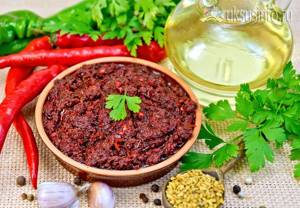
Preparation:
- Peel the pepper, remove the stem and seeds. The more seeds you leave in the hot pepper, the hotter the adjika will be.
- Peel and rinse the garlic.
- Grind all vegetables in a meat grinder or blender.
- Add spices, salt and vinegar (ground nuts if desired). Mix well so that the spices are evenly distributed throughout.
- Place in sterilized jars and store in the refrigerator.
Store adjika prepared in this way in the refrigerator for several months without fear that it will spoil. The seasoning can be served with any dish.
How to buy good quality vinegar
High-quality essence is sold only in glass bottles. There should be three convex rings on the neck of the bottle to warn visually impaired people that the product is dangerous for ingestion. There are also four horizontal stripes on the bottle; between the bottom two there is a manufacturer’s stamp on the inner surface of the glass. The label indicates the concentration of vinegar - 70%. When shaken, the contents foam, then within two to three seconds they become the same. If the bottle is counterfeit, the foam will last longer than ten seconds. Do not buy counterfeits, they are harmful to your health and, at best, will ruin your prepared dishes and preserves.
Usually the label gives very brief instructions on how to dilute vinegar essence. Manufacturers write that you need to dilute the original product with water one to twenty. To obtain a solution of different concentrations, the amount of starting ingredients will be different. You can use a mathematical formula.
A little about each
- Wine vinegar comes from the French. It can be made from white wine or red. It gives dishes a refined and unforgettable taste, which could not go unnoticed - people have found wide use for the product. Usually they make marinades with it and season salads with it.
- Apple cider vinegar is lighter and milder. Americans prefer it to a greater extent. They use this product for fish broths, chicken dishes and apple compotes.
- Rice vinegar is a product primarily used in Japanese cuisine. The Japanese prepare this type of vinegar and use it in rice dishes. In particular, they are used for making sushi and rolls. The recipe for this product is quite simple; any novice cook, or just an amateur, can implement it.
Using vinegar in different concentrations
Quite often, diluted vinegar is used in home medicine. Compresses with vinegar are good for reducing fever. To use this folk remedy, you need vinegar at a 6% concentration.
The end of summer and early autumn is a troublesome time for all housewives. This is the time to prepare for the winter - pickling, canning, boiling. In general, my mouth is full of worries. And this often happens when, in the middle of the canning process, it suddenly turns out that there is not a drop of vinegar in the house. It doesn’t matter, in this case there is a more thrifty neighbor who will always come to the rescue. Only bad luck - my neighbor happened to have 70% vinegar essence, but it’s not suitable for preservation. There is only one way out - dilute it. Today we will tell you how to dilute acetic acid 70 to 9 percent and not disrupt the stockpile.
How to use the vinegar concentration calculator
Many housewives are faced with a situation where the recipe for a dish calls for 5% vinegar, but only 70% essence is on hand. In order to dilute the acid to the required value, you can use the online vinegar concentration calculator - it’s very simple, quick and easy.
All you need to do is enter information in special lines about what concentration of vinegar you need to get, what volume of preservative is required, and the concentration of acid that will be used as a base. It is also necessary to introduce a measure for measuring the vinegar product - milliliters, grams, teaspoons, dessert or tablespoons, or faceted glasses.
After entering the data online, the calculator will instantly calculate the required amount of vinegar base and water for dilution.
What is vinegar essence
First, let's clarify what vinegar essence is. This is a 70% aqueous solution of acetic acid. This solution contains 7 parts acid and 3 parts water. Sometimes you can find 80% and 30% essence on sale. Accordingly, in the first the ratio of acid and water will be 8:2, and in the second - 3:7. Such concentrated solutions are dangerous; if taken orally, they cause burns to the mucous membranes of the digestive tract. In industrial production it is called the food additive E260, and housewives use it in the kitchen and for household purposes in the form of diluted table vinegar. Table vinegar is also sold in stores, its concentration ranges from 3% to 9%. In addition, on the shelves you can find vinegar made from natural raw materials: apple, wine, malt, balsamic, sherry and even coconut. This product is used for preparing culinary dishes.
And yet, the essence is most in demand for everyday needs. After all, from one teaspoon you can prepare a whole glass of table vinegar. Before we learn how to dilute vinegar essence 70%, let's focus on the quality of the original product.
Precautionary measures
70 percent acetic acid is a dangerous product that must be used with strict adherence to all personal safety rules.
Basic rules for using acid:
- 70% vinegar essence must be stored away from children and direct sunlight.
- To ensure that the prepared preservative does not lose its taste and aroma, it is recommended to store it in a tightly closed glass container.
- When diluting vinegar essence, you must follow all safety precautions. It is recommended to dilute acetic acid while wearing rubber protective gloves.
- If acid gets on exposed skin, rinse it with plenty of running water.
- Vinegar vapors are poisonous to humans and can lead to intoxication. Therefore, when working with a preservative, it is recommended to use a respirator.
- When diluting the essence, a preservative is added to the water, and not vice versa.
- When diluting the vinegar essence, it is necessary to open the window, and after completion, thoroughly ventilate the room.



